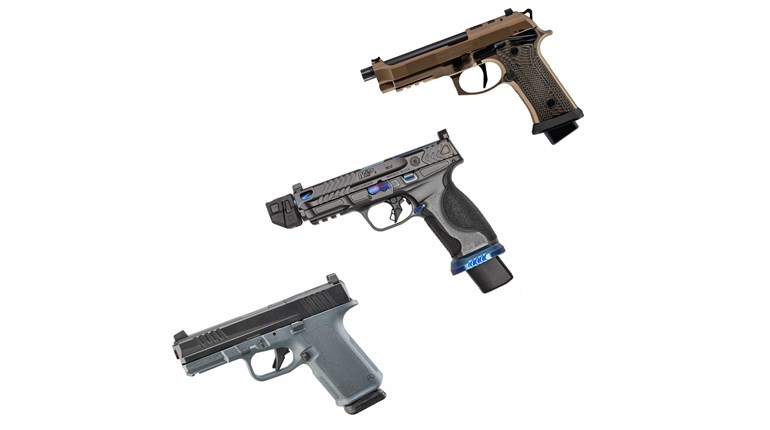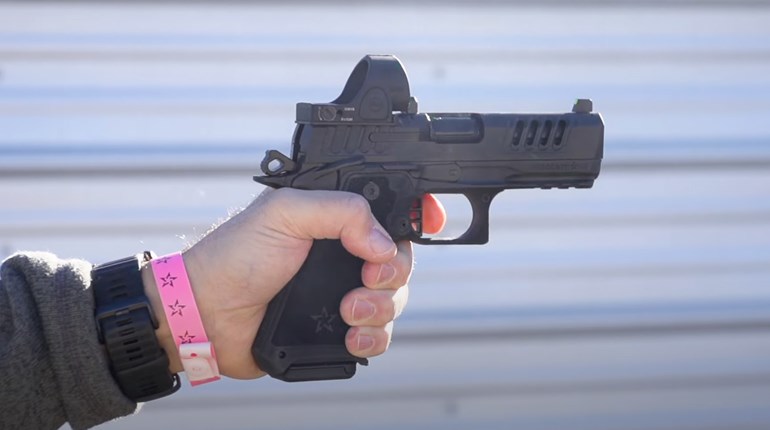
One trend I spotted at the 2023 SHOT Show was the increasing popularity of single-action, metal-framed 9mm pistols with double stack magazines. Staccato has built their reputation on that sort of pistol, Beretta rolled out a single action version of the iconic Model 92 pistol, Dan Wesson rolled out the DWX (for real), and Springfield Armory was showing off the new DS Prodigy. Polymer-framed, striker-fired pistols used to rule the concealed carry market, but lately, it seems all the cool kids are moving towards metal frames and manual safeties.
Which is a bit ironic, because that’s exactly how the double stack pistol market started, almost 90 years ago. Pretty much every 9mm semi-automatic can trace its heritage, in one way or another, to the iconic Browning Hi Power of 1935. Metal frame? Yep, it has one. Double stack magazine? Ditto. 12 or more rounds of 9mm? It’s in there. Single action only, with a manual safety? ¡Mais oui, bien sûr! In short, practically everything you see on a Staccato, Witness 2311 or similar gun of today first showed up on a gun that’s about to become a nonagenarian.
The Double Stack Revolution Begins
Which is probably why the Hi Power turned out to be a runaway hit. It’s one of the few guns which can say it’s faced itself in armed conflict, and is so popular, it is still in use today by law enforcement and military agencies all over the world.

But it probably isn’t the first gun you think of when you’re looking for a concealed carry pistol. Which is a shame, because modern day interpretations of the Hi Power, like the FN High Power, Springfield Armory SA-35 or the MC-P35 from Girsan/EAA are absolutely terrific guns for this purpose. However, the same metal frame that allows these pistols to suck up recoil also means they can seem a bit heavy to carry around on a day in, day out basis.
Competition Is A Proving Ground
Let’s pause for a moment and talk about the world of practical shooting, where using a heavy pistol that can help with recoil is actually a good thing, as it speeds up your time on a stage. One company in particular, STI, was known for making high-quality single-action double-stack pistols that ruled the roost in the Limited Division, where the rules favored that kind of gun.
Flash-forward a few years. Wilson Combat, a company that’s also very well-known and well-loved in competition circles, comes out with the EDC X9, a pistol that’s roughly the same size and shape as a Glock G19 but with a metal frame and a much better trigger. STI then rebrands itself as Staccato, revamps its guns to make them more suitable for daily carry and law enforcement use, and we’re off to the races.
The question remains, though, is a single action, double stack pistol better for concealed carry than something which is striker-fired with a polymer frame?
Well, that depends on a number of things. The first question you need to ask is, how much time do you want to put into learning how to operate your gun? I can’t tell you how many students I’ve seen on the range who draw a pistol with a manual safety, the point it at the target, press the trigger and then just stand there with a puzzled look on their face when it didn't go “bang” because they forgot to switch off the safety as part of the draw stroke.
Whoops.
This sort of thing can be overcome with regular practice and familiarization with your pistol. The safety on a striker-fired gun is usually integrated into the trigger itself, giving you one less thing to worry about before you send rounds downrange. As was mentioned before, because the weight of the gun can help control recoil, a metal-framed gun is easier to shoot. However, that extra weight makes it harder to carry around. A good gun belt and a good holster can help mitigate this, but physics will be physics, and lighter guns will always be easier to carry.
Trigger Effect
Lastly, there is the trigger, which is probably the biggest advantage a single action gun has going for it. Typically, a single action trigger does just one thing: Drop the hammer and start the ignition sequence of the cartridge in the chamber. On a striker-fired gun like a Glock, though, pressing the trigger means finishing off the cocking of the striker, and that requires more effort and more movement of the trigger.
Pressing the trigger is the last thing you do before the gun goes “bang,” so any movement you add to the gun as you do this task is going to affect where the round lands on the target. Less effort and less movement of the trigger translates into fewer opportunities to move the gun as you press the trigger, which is why guns with shorter and lighter trigger weights tend to be more accurate than pistols with heavy trigger weights and long trigger pulls. Learning to shoot a gun with a heavier, longer trigger takes more training, but if you can master that sort of trigger, you can shoot almost anything.
As my friend and firearms trainer John Murphy once said, if you’re used to the long, six or more pound pull of a striker-fired gun, the short, light pull of a single action pistol seems like “cheat mode,” which may explain why single-action double stack guns are gaining so much popularity these days. It may seem like something new, but really, all we’re doing is returning to the roots of the 9mm defensive pistol.




































